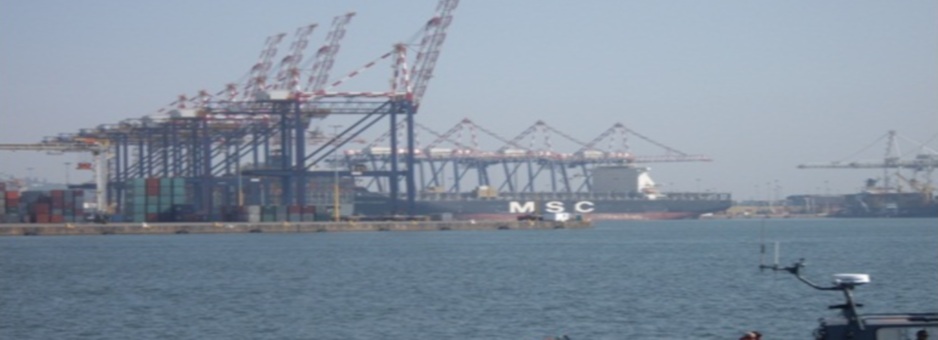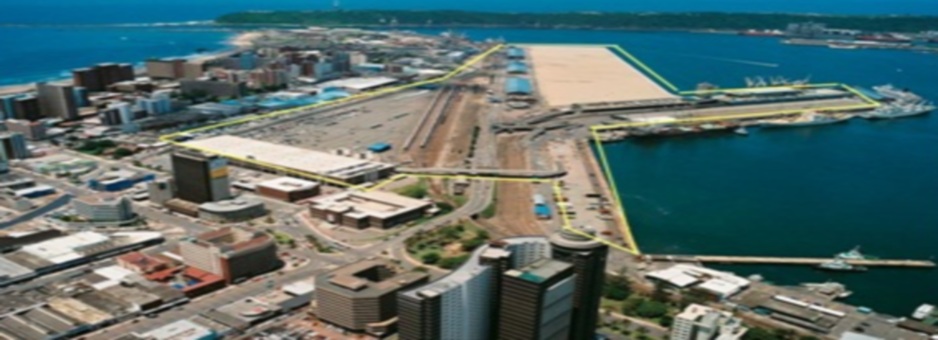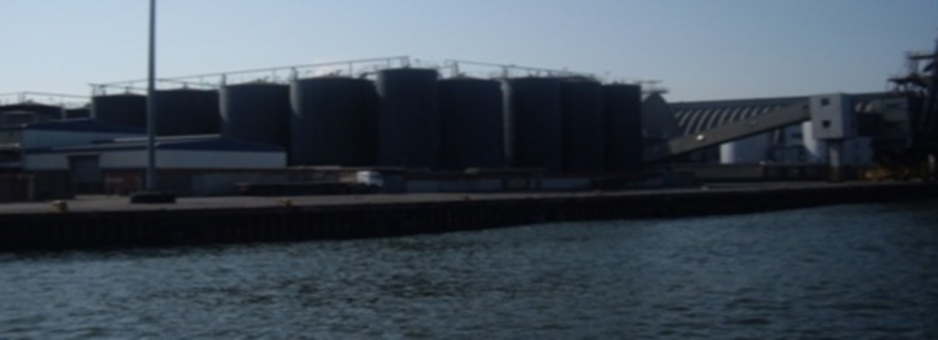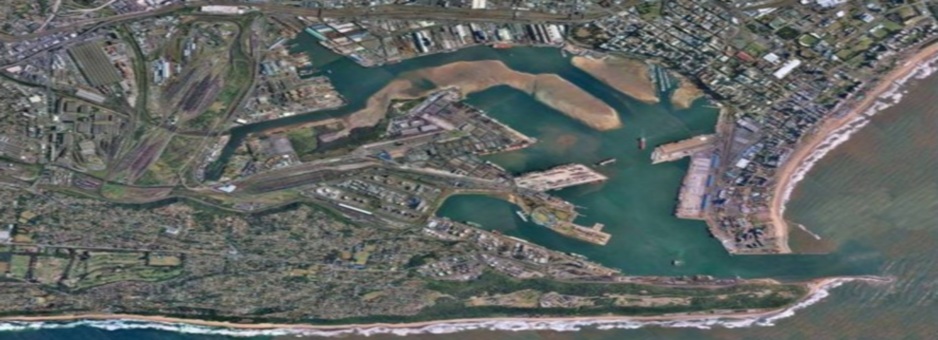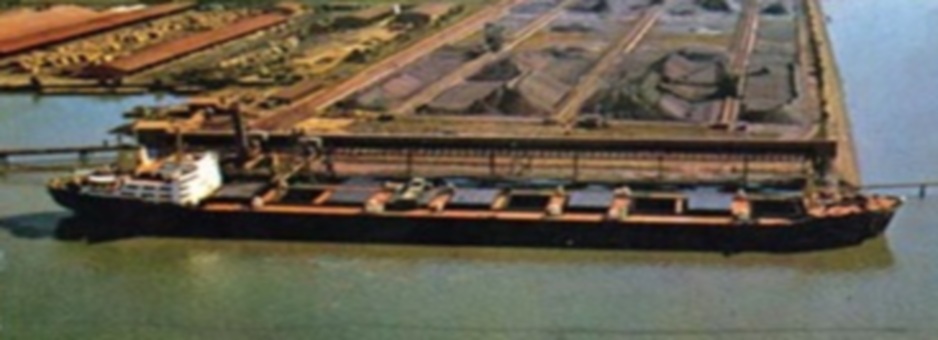Introduction
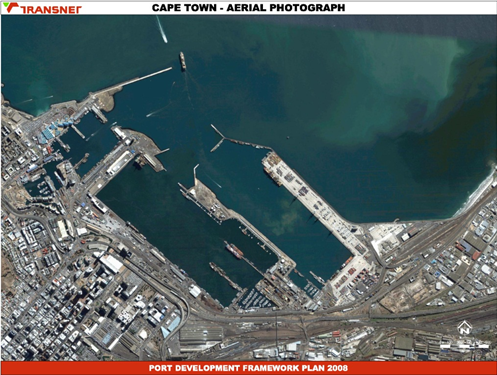
Photo: Port of Cape Town - Aerial Photograph Source: TNPA 2010
The Port of Cape Town is located within the municipal jurisdiction of the City of Cape Town, Western Cape Province at the southern tip of Africa, on the Southern Ocean trade route with a relatively restricted hinterland, and small industrial base. It is situated approximately 1500 kilometres from South Africa's industrial heartland of Gauteng.
The Port currently handles 3,000 - 4,000 vessel arrivals per annum with core business in container handling, ship repair; the fruit export industry, break bulk, fishing, and bulk oil to a small extent cruise liners. Although it is relatively landlocked with limited expansion options, it continues to be a full service general cargo port with "24-hour" port operations. The Port stands second nationally in Container Handling capacity of 735,000 TEU's with ground slot capacity of 4,372 and reefer points of approximately 2,000. Besides its picturesque location, the port functions as part of a complementary port system, to the Port of Saldanha that lies less than 140 kilometres on the northern part of the western coast of the province. It currently facilitates between 4,000 - 5,000 vessel arrivals per annum with core trade business summed as follows:
- Container Handling,
- Fruit Export Industry
- Ship Repair Industry
- Break Bulk, Fishing Industry,
- Bulk Oil and,
- Cruise Liners (smaller operation)
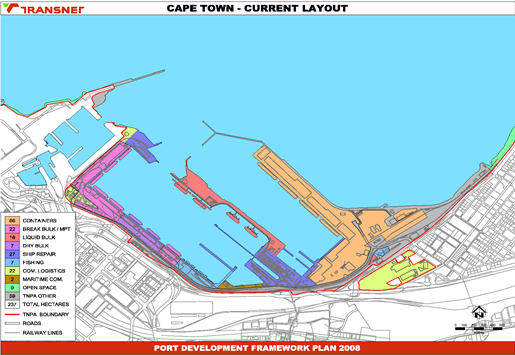
Plan 1: Port Layout 2040 Source TNPA 2010
Port Infrastructure
Rail is the dominant carrier of goods and caters for 88% of cargo handled due to the established existence of coal handled by the port via the COALlink. Road traffic is significant but restricted to the Multi-Purpose and Dry Bulk Terminals on the northern end of the port. Finally, conveyors link to neighboring industries such as Billiton Hillside, Foskor and Woodchip plants for dry bulk cargoes.
Road Network
Both road and rail networks currently serve the port. Rail is not the dominant carrier of goods mainly due to the predominance of the containerised and break-bulk products handled by the port. Previously, the public to connect to the CBD used Duncan Road. The road will be completely closed to the public as of March 2007. The road network serving the Port can be broken down into 2 distinct parts. Firstly, the external street network, which services the port directly but contains a mix of port and public traffic, is as follows;
- N1 Table bay Boulevard - Major 6-lane dual carriageway freeway, mainly on the perimeter of the port linking the 4 entrance points.
- Marine Drive - Major 4 -lane dual carriageway arterial, mainly serving Duncan Dock, Ben Schoeman Dock and the Container Depot,
- N2 Eastern Boulevard - Major 4-lane dual carriageway arterial joining the N1, serving Cape Town CBD from the Southern Suburbs.
- Dock Road and South Arm Road - 2-lane single carriageway, serving the V&A Waterfront and Duncan Dock as well as South Arm Road.
- Heerengracht Street - 2-lane single carriageway, access to Port via Duncan Road.
- Oswalt Pirow Street - 2-lane single carriageway, access to Port via Duncan Road.
With some exceptions, these roads all suffer from congestion during peak periods due in part to their close proximity and location within the Cape Town CBD and the Rat Running traffic using Duncan Road to travel to the CBD.
The main internal roads within the Port are:
- Duncan Road - 4-lane single carriageway to 2-lane carriageway - spine road within the Port.
- Container Road - 4-lane duel carriageway - collector within the Ben Schoeman Dock and link between Marine drive and Duncan Road.
- South Arm Road - 2-lane road access to South Arm, V&A Waterfront and the North side Duncan Dock.
Rail Network
A comprehensive rail network served from two main directions services the Port:
- Rail Access No.1 from the North (Milnerton) via Bull Nose, along the Atlantic Ocean.
- Rail Access No.2 from the east via Bay Junction
Cargo transported by rail is less than 10% mainly due to the poor competitiveness of rail over the short distance to the Western Cape hinterland, which is the main service area of the Port. The Ben Schoeman Marshaling Yard, the only significant yard within the Port boundary is under-utilized. Short-term plans are to cover 50% of the tracks in order to provide temporary stacking area for empty containers.
The internal rail network runs along Duncan Dock Road at the back of the landside operational areas. Due to the under-utilization of rail infrastructure and to reduce maintenance costs, all overhead track equipment (rail electrification) have been removed, therefore all rail traffic is not electrified. Based on the present modal split between road and rail, the present rail infrastructure in the port is grossly underutilized and would require significant upgrade, due to a lack of maintenance
Port Parameters (Source: Port of Cape Town Asset Profile Report 2004)
The Port's marine infrastructure characteristics and conditions observed are presented in the table below. They reflect the existing quays and other related structure depths, lengths and conditions. In the subsequent tables, infrastructure characteristics, condition and inventory are presented. For the V&A the berthing facilities are as follows:
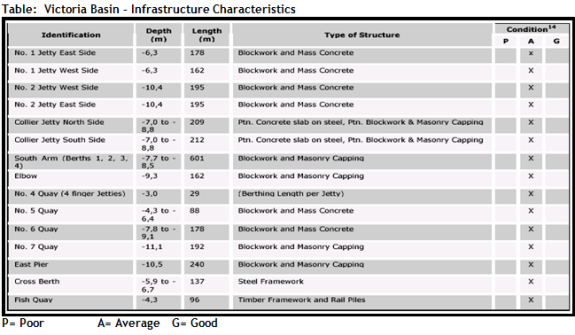
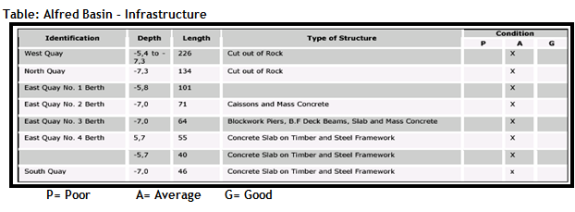
Duncan Dock and Ben Schoeman Dock are the main cargo handling areas of the Port. Waterside access is gained via a North-South 45m wide approach channel that can accommodate vessels with a maximum draft of 15.9.m. Access is protected by the main breakwater structure that is 900m long. Movement of vessels into these areas of the Port is accommodated as follows: Duncan Dock leading line approach is on bearing 198� 30. Provision is made for a 300m diameter-turning circle located just inside the basin between Berths A & H. Ben Schoeman Dock leading line approach is on bearing 131� 31. A 300m diameter-turning circle is located at the entrance of the basin, to the South of Berths 700 - 703. The turning of Container vessels in Ben Schoeman Dock generally takes place at the Southern end of the basin and not at the demarcated turning circle. This operation restricts the present reclamation of land on the western side of the dock to allow for at least a 400m clear distance from the eastern quay.
Plan 2: Port of Cape Town Future Layout Source TNPA 2010
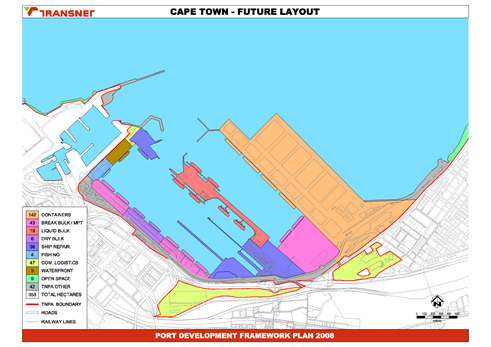
Table: Duncan Dock 15 - Infrastructure Characteristics
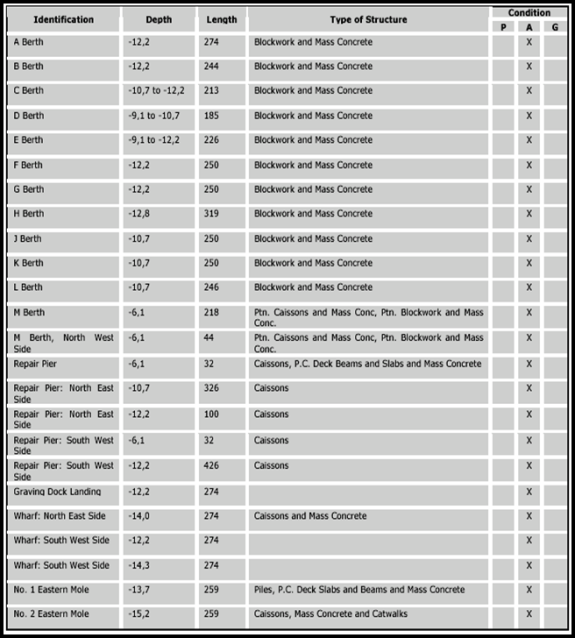
P= Poor A= AverageG= Good
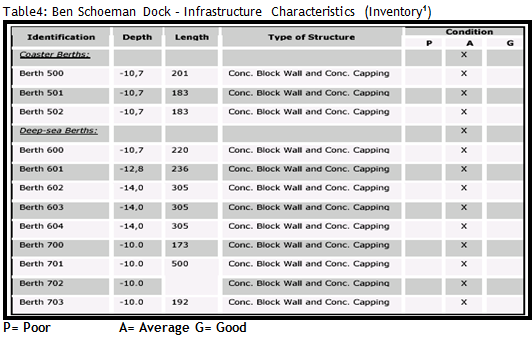
Port Terminals
Tables contained in this section represent terminals, berth details and commodities handled by respective operators.
Cape Town Container Terminal (CTCT)
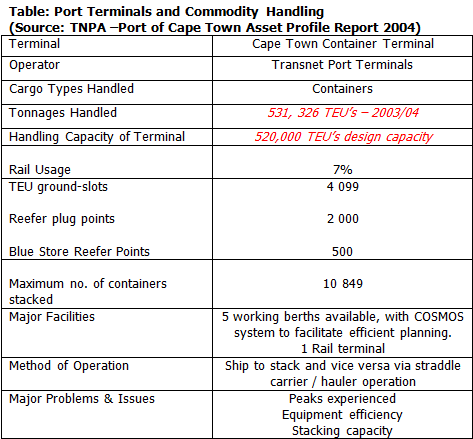
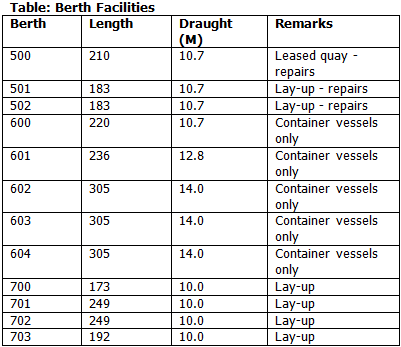
Multi-purpose Terminal
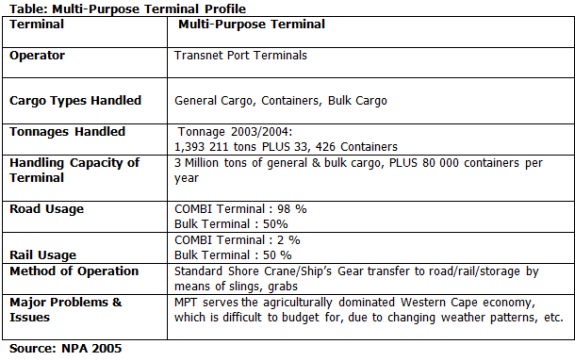
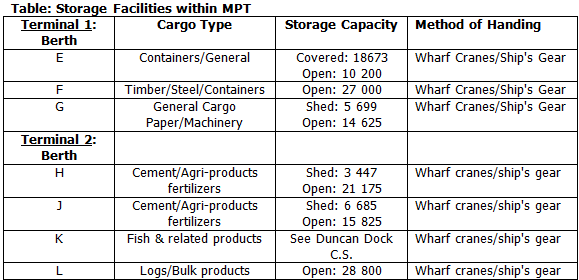
Cape Town Fruit Terminal
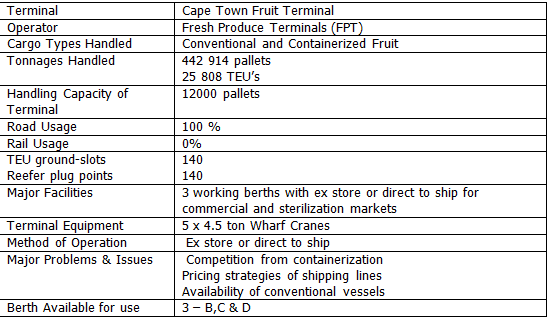
Introduction
Two critical components help assess port strategic fit and positioning, i.e. cargo previously handled and projected. This is best determined by quantifying "port activity" the last four years (2004-2009) as well as current activity; i.e. vessel arrivals (type of vessels and volumes contained); cargo volumes moving across the quays; commodities handled and also which commodities have consistently performed best.
Vessel Arrivals
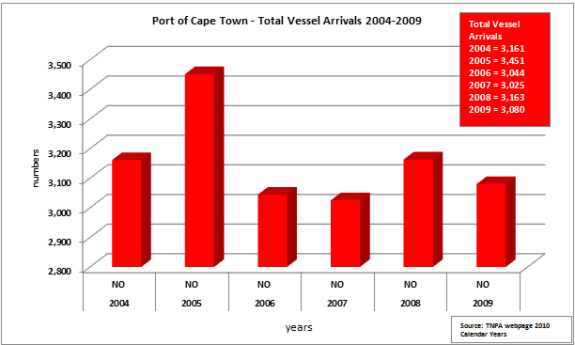
There has been an unstable trend in total number of vessel arrivals, with 2005 having the highest recording of 3,451 with the lowest figures in 2007 at 3,025. Note that figures for August 2010 - 2011 are not included due to "unforeseen challenges" a brief view of 2010 sourced from Transnet Webpage presented (Jan- July 2010).
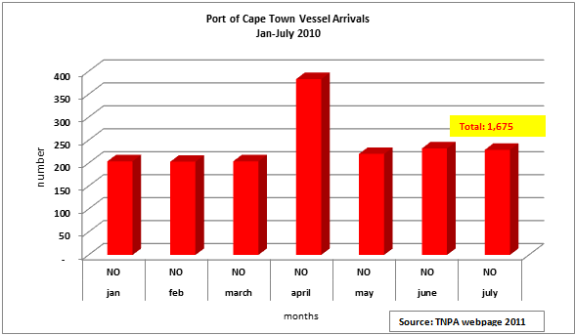
Based on the vessel arrivals at 1, 675 in July 2010, inferences can be made that figures between 1,400 to 1,500 were recorded between August and December 2010 making final calendar vessel arrivals more or less consistent with previous counts, i.e. between 3,000 to high 3,100 by year-end. If lower figures are recorded, it can be attributed to economic slow-down and the after-effects of the Transnet strike during 2010.
Cargo Trends in the Port (2004 - July 2010)
Cargo types primarily moved through the port (2004-July 2010) are categorized into the following main groups: Break Bulk, Dry Bulk, Liquid Bulk, Containers.
Break Bulk- Dominant commodities
- Fruit (deciduous, citrus, sub-tropical, etc.)
- Steel Products
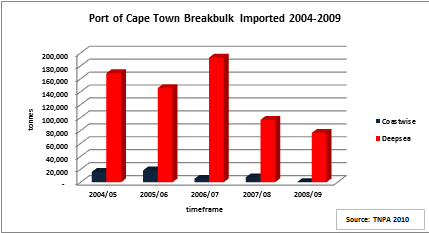
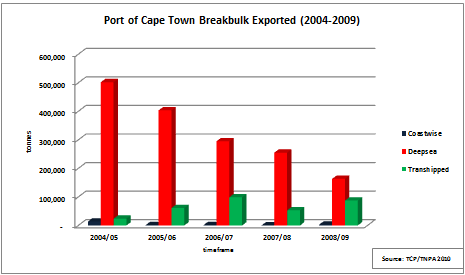
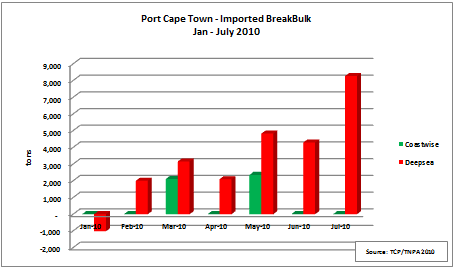
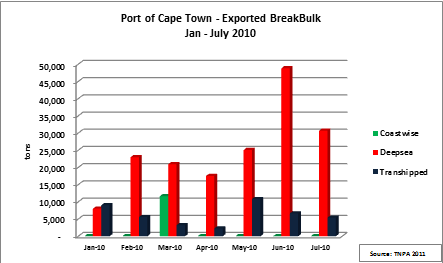
Breakbulk import vs. export ratio is predictably skewed towards higher exports. Even with the brief trading of Jan - July 2010 figures, the relationship remains. In terms of transshipments, the port plays a somewhat limited role as seen by the low figures.
Dry and Liquid Bulks
- Dominant Dry Bulk Commodities
- Maize
- Rice
- Grain Products
- Dominant Liquid Bulk Commodities
- Petroleum Products
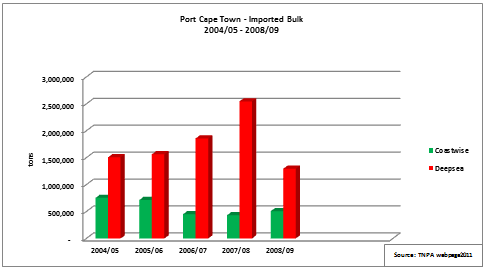
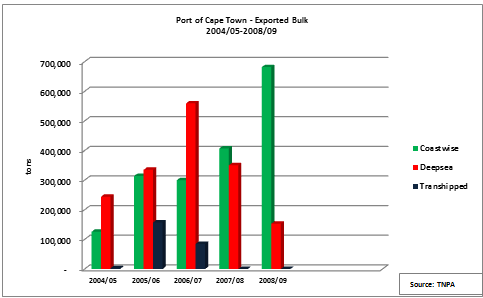
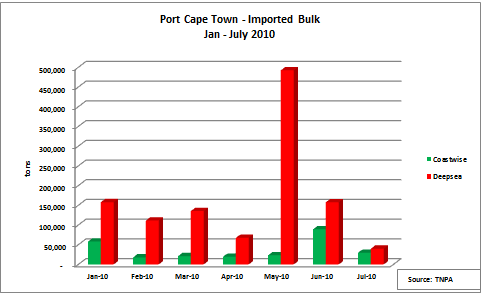
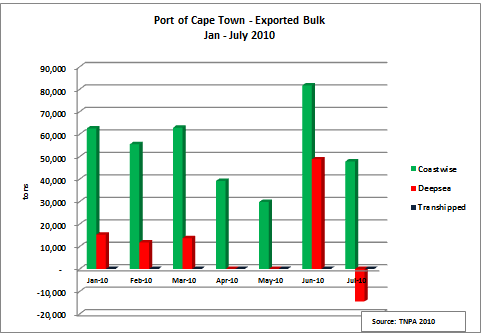
Maize, Rice and Grain products remain the most dominant dry-bulk commodities in the port while petroleum products remain the dominant in the liquid bulk sector. The ratio between imports and exports is highly skewed towards exports with transshipments (exports) enjoying strong figures at 157,578 during 2005/06. Coastwise activity was strong during 2010 (Jan-July) with highest figures observed in June. Assumption is that numerous activities resulting from the World Cup increased traffic between coasts.
Containers
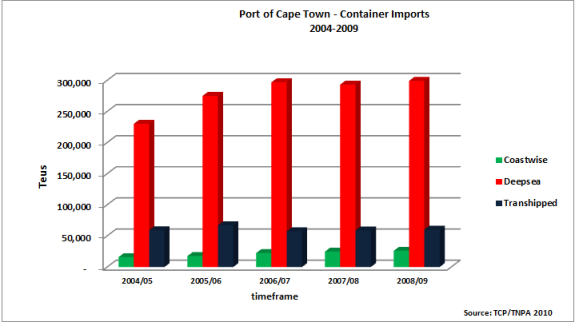
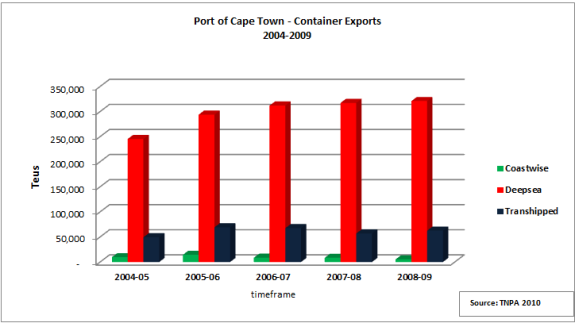
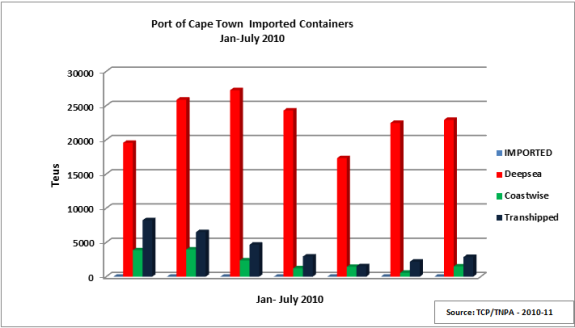

Containers through the port were relatively adequate totaling 774,238 (both exports and imports) in 2008/09. Imported containers reached the highest in 2009 at 299,156 Teus compared to exports during the same year of 320,889 Teus. The lowest figures recorded are in 2004/05 where both imports and exports were low at 230,239 and 245,238. respectively. NOTE: containers refer to both normal containers as well as reefer containrs exporting fruit and vegetables to markets in Europe and America.
Port Demand Framework and Assumptions
The basic principles applied for developmental (spatial distribution; forecasting, etc.) planning purposes are as follows:
- Capacity Calculation = port transhipment + import + export + empties
For Automotive sector, forecasting is conducted in tons. The conversion to units is as follows:
Automotive Conversion
- Corrective forecasting measures were applied in 2007/08. Predictably, growth has been affected by the world recession, thus infrastructure in most instances has been developed too ahead of demand. A moderate and balanced approach to mitigate against (low and high) growths has been to merge the short term fluctuation in the growth of the economy with the long term 30 year forecast.
- Of importance to note is the unique "grouping" of cargoes used in South Africa vs. those in Europe. Instead of a 62 commodity system, South Africa utilises a 92 commodity system. This is best observed in projected bulks (break, dry and liquid). To achieve better "comparability" total volumes per cargo are proportionally distributed across the port system. In the following graphs there is SA Ports imports (based on 62 commodity system) vs. NPA SA imports "adjusted" according to NPA type split.
- The demand forecast is for the next 4-5 years (2010- 2015).
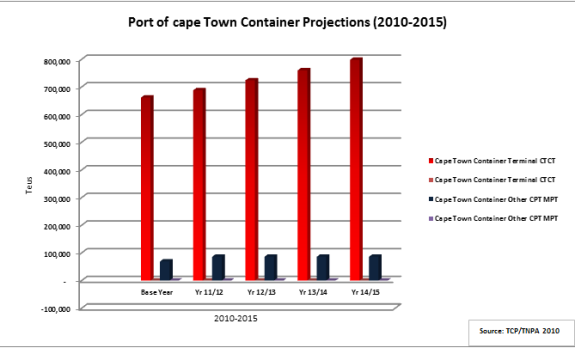
On average container growth will not increase more than 5% during each year. From base year (2010/11) anticipated growth between the next 5 years will be 2%, 4%, 5.2%, 5% and 5% respectively. This is in concert with estimated GDP and international economic growth for the same periods.

Similar to container growth, vehicles tend to reflect what the economic trends are domestically and internationally. Given that we export as well as import cars, the future growth trends will be the between base year (2010-11) to 2015: high 59.2%, a dramatic drop (recession and rand/dollar ratio) of -80.4% and tapering off to 0% the next successive years, respectively.
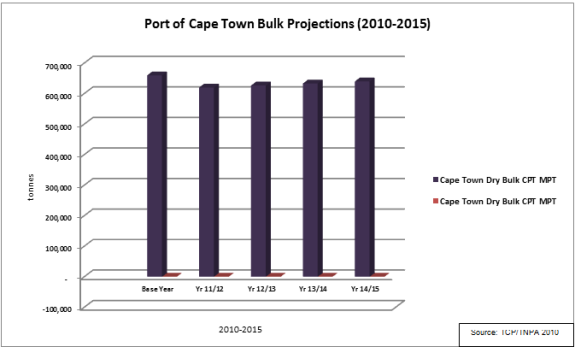
According to Transnet, dry bulk cargoes and their projected growth and movement will be dependent on Transnet Freight rail (TFR) expansion program. These volumes in turn will be dictated by demand (market and prices). For projected growth in the port, bulk cargo will have negative growth the next two years (2010-2012) at -8.8 and -6.1%; thereafter, (2013-2015) a minimum growth of 1% to 1.1 and 1.1% respectively.
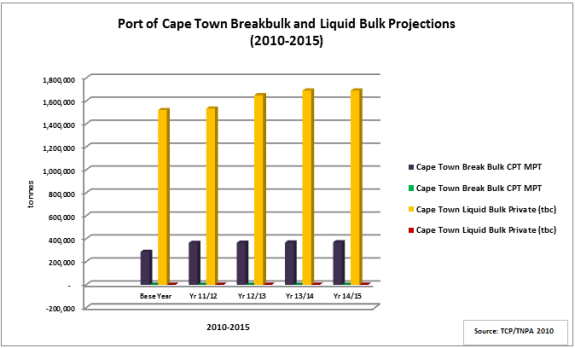
Deviations exist between break-bulk compared to dry and liquid bulk overall. Break bulk figures will have a sharp negative drop at -39.7% at base year, thereafter, increase to 27.1% then drop to .5% the following three years.
Liquid bulk will also have a negative growth at -16.4 during the base year, then slowly recover to .9, 7.6, 2.9 and drop to 0% by 2015. Totals for import and export will continue to be comparable with the significant differences observed between the three package type (break bulk, liquid and dry bulk).
Some of container and break-bulk cargo destined for the Port of Cape Town has in recent years diverted to the Port of Ngqura in the Eastern Cape. As a result the growth trends especially in break-bulk is likely to tapper as new contracts/lease and operational agreements are put into effect. This is accommodated accordingly between container/break-bulk and transshipments in the port.
Consequent to these events taking shape, there is a reality that the Port is in a constant state of motion. Opportunities identified such as the Oil and Gas, logistic centres for commercial marine operations and other economic development projects will bring newer port services and industries that can be accommodated in the port. In line with "these" opportunities will always be the current cargo handling, distribution and specialised service industries delivery system. These in total have the potential to double or triple the direct and indirect contribution of the Port to the GDP. The road to such growth will require a contextualized collective Transnet Infrastructural Investment vision for the future and a framework to formulate policies that will guide development challenges.
Copyright © 2012 Limpopo Province Freight Transport Data Bank | Developed and Powered by Safiri South Africa.

